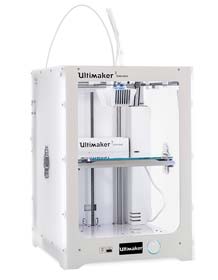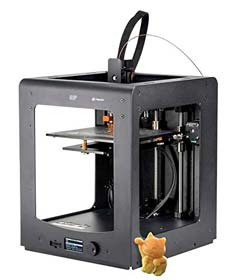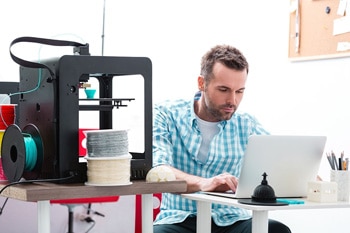
Any architecture student will recall with a shudder, the hours spent creating models of their designs for projects and presentations.
Similarly, interns at interior design and architecture firms labored over these designs all night, creating life-like models to present to clients.
The invention of 3D printers changed all that as they take a fraction of the time compared to hand-made models, and come out looking much better.
However, with all the 3D printers out there, finding the right one for designing buildings and structures can be difficult. And that’s why this article brings you the best 3D printers for architects.
Benefit of Using 3D Printer For Models
Accuracy And Detail
3D printed models are much more accurate when it comes to dimensions, angles, and all the other finer details that are sometimes overlooked through human error. A 3D printer for architectural models will also pay more attention to detail, making a model look much more life-like and realistic.
Furthermore, the precision provided by 3D printed models allows architects to better communicate their ideas with clients, and get their vision across much more clearly. Clients can also see what their project looks like throughout its different stages and provide input on any changes that they want.
Lower Costs
As any architecture student will tell you, the materials needed for making architecture models can rack up quite a hefty bill. They can also be troublesome to track down. On the other hand, a 3D printed building model is much cheaper to produce.
3D printing for architects can cut down costs by nearly 75%. If you get yourself one of the best 3D printers for architects, the only recurring cost will be that of the printing materials, most of which are affordable.
Read More: How Long Can You Leave a 3D Printer Running? If you’re an architect, you may need a printer to print a big project. (They can run longer than you think!)
Improved Model Quality
Unlike traditional hand-crafted architecture models, the 3D-printed versions are much more durable. They can withstand complicated designs and layouts without collapsing under their weight as printing materials like polypropylene, yet tensile. Also, architectural 3D printing allows models to be printed in colors making them look more realistic and attractive to clients.
Read More: What Causes Stringing in 3D Printing? Learn why your prints aren’t coming out as they should with our short guide!
Top 9 Best 3D Printers for Architects 2021
1. Dremel DigiLab 3D45 3D Printer
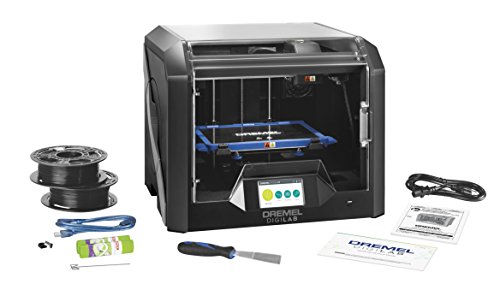
This 3D printer for architectural models is well known for its capabilities and has even won a couple of awards. It has a range of features that cover various printing needs and was designed to be used by professional engineers, designers, and architects.
So what makes it the best 3D printer for architects? For starters, it is compatible with a range of operating systems like Windows, Mac, Chromebook, and iPads and comes with cloud software as well.
This means that you won’t need to get a separate device for your 3D CAD designs and printing them. Moreover, the cloud software adds a layer of protection, preventing any loss of data.
There are also several connectivity options like Wi-Fi, Ethernet, and USB ports, each of which helps hook up the 3D printer to the device you are working with. As far as printing quality, it is compatible with several printing materials and includes a special sensor technology that prevents the extruder from getting clogged. This makes for a smoother printing process, reducing the chances of errors.
The reliability of the DigiLab 3D45 comes from the carbon and particulate filter which also keeps the printed models precise, accurate, and scaled to the right proportions. It is very convenient to use, thanks to the filament recognizing technology.
It automatically updates the extruder and builds plate temperatures, and print speeds based on the kind of filament being used, so you won’t have to start from scratch if you run out of filament and then get a refill.
Many older models have issues with printing materials like nylon and ABS. But the glass plate of this printer can heat up to 100°C, and the 0.4mm metal nozzle can be heated to 280 °C, so you can print all materials without any trouble.
The DigiLab 3D45 also has a semiautomatic leveling technology, allowing for easier and faster calibration. In addition, you can adjust the leveling plate by turning a knob in real-time.
Highlighted Features:
- Includes an HD camera so you can monitor the printing process.
- The sizeable printer allows you to print larger 3D models.
- Filament recognizing technology makes it more convenient to use.
- Compatible with most operating software.
- Generates a higher temperature to print various materials.
2. QIDI TECH 3D Size X-Plus Printer

Want to print a 3D model using two kinds of filament? You’re in luck because the QIDI 3D printer has innovated assigning the filament in two different ways. Whether you want enclosed constant temperature printing or ventilative printing, the choice is all yours!
Unlike older models that can print a handful of materials, this printer has extruder assembly of two different kinds. The preinstalled extruder has a maximum printing temperature of 205°C and is meant to print using materials like ABS, PLA, and TPU.
On the other hand, there is a secondary extruder that you can use whenever needed, with a printing temperature of 300°C meant for printing materials like Carbon Fiber, Nylon, and PC.
It offers reliable printing quality, due to the double Z-axis driver, which offers more stability and precision when printing larger 3D models. This factor, as well as the slicer software version 5.0 and the reformed, smarter UI interface of QIDI software, makes it one of the best 3D printers for architectural models in professional spaces.
This software improves the slicing algorithm compared to previous models, which improves both printing quality and speed. Users will also like that the printer works without too much noise, compared to the earlier generation, which results in fewer distractions as you work. Furthermore, it has Wi-Fi connection, single-button leveling, and a host of features that make it more convenient to use.
Read More: What is Slicing in 3D Printing? We discuss slicing in this short guide to help you define terms!
Highlighted Features:
- Double Z-axis translates to sturdier and more stable 3D printed models.
- The inclusion of two extruders allows you to print with a variety of material.
- Allows for printing filaments in 2 different ways.
- The metal plate is removable and reusable.
- The large 4.3-inch touchscreen has a simple interface.
3. MakerBot Replicator + 3D Printer

The Replicator 3D printer is a solid option when it comes to heavy-duty 3D printing. You know this is true is you’ve seen Maker architect 3D printer reviews.
It has been designed for faster and more efficient printing. The speed, together with the MakerBot’s strong workflow tools makes it suitable for use by educators and those teaching or practicing 3D printing architectural models.
This printer handles faster and better performance and does so through a sturdier design and construction. Moreover, the larger size allows for larger and more precisely printed models without any loss of accuracy or detail.
However, the most striking feature of the Replicator is the Smart Extruder which provides very detailed results with different materials like polylactic acid, allowing you to create various models that are flexible and realistic.
Moreover, it is cloud enables so you can control with their mobile app while you are on the go. Also, the flex build plate uses a grip surface technology, which lets the printed material adhere to each other better and warps or bend less during the process.
There is an intuitive dial that allows you to calibrate the dimensions of your model more easily, and the LCD provides a straightforward user interface, which lets you preview the file you want to print, and set up or maintain the printer.
Highlighted Features:
- Allows you to monitor the printer with an on-board camera.
- Smart Extruder improves print quality/performance and allows for heavy-duty use.
- Grip Surface boost filament adherence and prevents breaking or bending.
- Comes with MakerBot print which is free software that streamlines the 3D printing process.
- The LCD interface is easy to use.
4. QIDI Technology Resin 3D Printer S-Box

QIDI manufactures two kinds of 3D printers: FDM printers like the X-Plus printer, and LCD resin printers like this S-Box.
So, what makes the S-box different from the X-Plus? It is a larger resin with a more unique structure for printing and leveling. This makes it easier to use, due to the double layer insert structure and one-key leveling option.
The structure is constructed from one-time cast aluminum molding, which stabilizes the printed model, especially larger ones without it bending or warping. It is also better for using with new generations of FEP film.
This 3D printer for architectural models comes with a whopping 10.1-inch high-precision screen and has 130-watt UV LED light sources. As a result, the light is more evenly dispersed and improves printing accuracy, especially with more intricate models.
Also, the structure makes use of double-line guard rails and the center is fortified with industrial-grade ball screws. It makes printing complex 3D models more efficient as it decreases the layer pattern and improves the stretching force.
Highlighted Features:
- Bigger size makes it possible to print larger 3D resin models.
- Z-axis motor comes with TMC2209 drive chip for intelligent and quiet printing.
- A large screen allows for more precision and better control.
- One-key leveling makes it easier for novices to use.
- Matrix parallel light source offers uniform dispersal of light for printing accuracy.
5. ANYCUBIC Chiron Printer for 3D Modeling

This FDM printer is much larger than conventional ones and will allow printing much larger 3D models which most cannot. 3D renditions will therefore be much more realistic, leaving more room for imagination, and improved visibility that allows you to see what needs to be tweaked and changed.
But how does this unit prevent larger models from collapsing on itself? There is a special hot-ended high-precision nozzle that decreases the weight on the X-axis resulting in a better performance even on very high points, making the overall structure more stable.
It also features semi-automatic leveling and resumes print options. This component can sense 25 points, manage real-time adjustment of the nozzle, and even continue printing after a power outage. As a result, you can print large-scale 3D models with more convenience, fewer errors, and in greater detail. Most other printers won’t be able to print anything in such a large size, much less with proper precision.
Besides, the printer uses a high-grade Titan extruder, allowing users to experience smoother action, an easy-to-use interface, and the ability to print offline. It makes the printer much easier to use by everyone, even those who aren’t very computer literate.
This means that it is a more convenient choice if lots of different people are going to use the printer, as opposed to newer, more high-tech 3D printers that are meant for experienced professionals.
With this printer, you have more options when picking filaments; these include PLA, ABS, HIPS, TPU, and a lot more. As a result, different parts of your model can be made with different materials, giving it more dimension and realistic touch.
Besides being gigantic, the printer doesn’t require too much set-up, so you can have it up and running in no time at all.
Highlighted Features:
- Greater functionality with Ultrabase Pro, filament detection, and touch screen.
- Quick start setup makes it easier for beginners and amateurs to use.
- Can handle a range of filament materials.
- The large print bed makes it easier to print bigger models.
- Quick recalibration reduces chances of error and a lack of precision.
6. Ultimaker 3 Extended 3D Printer
Any architectural 3D printing service for pros should be able to print models using a variety of materials, making it easy to remove structures before presenting the finished product to the client. This is where the Ultimaker 3 gets to shine: it uses dual extrusion technology that takes printing complex architectural models to the next level.
It works because the two extruders can print different materials, a bit like the QIDI X-Plus. It allows you to print support structures using soluble PVA. This works because the structures can be rinsed under water to dissolve the PVA support, without manually trimming or sanding them off, making the end product look much more polished.
The two extruders also make it possible to print a single model using different materials and in various colors for a more aesthetic design. This makes things easier as you won’t have to manually paint any part of the model afterward, saving you a good deal of team.
Another advantage is that the printer is relatively quiet, which makes it more convenient for use in offices and classrooms. It is also reasonably sturdy, creating realistic and detailed 3D models without any hiccups. In a nutshell, the Ultimaker 3 works just as well as its more advanced sibling, the UM2+, and is good for precise and life-like models.
Highlighted Features:
- Wi-Fi functionality makes it easy to connect the printer to whichever device you use.
- Dual extruders boost performance and improve print quality.
- NFC fortified reels simplify printing complex models.
- Hot swappable print cores prevent loss of data.
7. FlashForge Creator Pro

Sometimes you just want a smaller 3D printer that can handle miniature models and earlier versions of the final model you want to put out. This petite printer packs more power than one would expect, with a sturdy steel frame, in contrast to the original one that had a wooden frame and was less stable.
It also emphasizes precision and accuracy with its 6.3mm thick aviation-level aluminum plate, which guarantees a flat surface, preventing bending, twisting, or warping. Together with a 10mm guide rod, the metal platform support promises an exact Z-axis movement and prevents the platform arm from deforming, which makes for a smoother printing process and improves the print quality.
The ability to use various filament materials makes this 3D printer impressive. PLA, ABS, Pearl, Elastic, PVA, HIPS, TPE, TPU, Conductive and PETG Filament are just a few that come together to create vivid and flexible 3D architectural models.
Compared to older versions, this 3D printer uses new LED lights in the printing area, which gives you better visibility of what is going on. This, in turn, makes it easier for you to customize settings and tweak the machine so it works according to your preferences.
There is also an acrylic cover that encompasses the chamber to insulate and protect the more delicate ABS prints. As a result, you won’t have to worry about warping or bending, even on more complex, ABS-printed models.
Highlighted Features:
- Compatibility with several kinds of filament materials.
- Aviation grade aluminum plate improves leveling, preventing bending.
- Guide rod allows for smoother and better printing.
- LED-lit printing area provides a clearer picture of how the model is printed.
- Extra protection for ABS prints.
8. Dremel Digilab Printer

Both amateurs and architecture students need to spend long hours printing different kinds of models, working with different print materials, and getting used to the idea of printing CAD files. This printer gives you just that and can print for hours without overheating.
This Dremel printer is extremely convenient because it comes pre-assembled, so you can use it right out of the box. It even comes with half a kilogram spool of filament and clear instructions for use. As a result, it is a good option for those who are using a 3D printer for the first time.
Also, this printer is compatible with the Dremel Digilab 3D Slicer based on Cura, a popular 3D printing software. It is particularly safer than many of its contemporaries, as it has a fully enclosed design and a non-heated build plate. Together, they decrease the chance of the prints being bent or warped.
You will be able to interact with the printer with ease, thanks to the full-colored LCD touchscreen. The interface is clean and simple, allowing users to alter settings and customizations, view the files on the SD card, and print without any issues.
If you want to introduce printing 3D architectural models to children or teens, this model makes it safe to do so. This is because the company’s non-toxic, recyclable, plant-based PLA filament is safe around children without compromising the print quality or damaging the models’ stability.
Highlighted Features:
- Enclosed printing space improves print quality by creating a stable internal temperature.
- PLA filament is engineered for strong prints with a high-quality finish.
- Comes with free cloud-based software.
- One-year warranty ensures that you are in good hands in case of damage.
- An instinctive user interface makes the printer easier to manage.
9. Monoprice Maker Ultimate 3D Printer
Architects and students who require a high degree of precision will be pleased with the Monoprice 3D printer as it offers a high degree of precision and exact detailing. This is since this printer supports 20-micron fine layer resolutions, so the print surfaces will be smooth and with lots of detail.
The extruder is made from metal, and together with the heated print bed, results in a 3D printer that can print almost any kind of filament material. This includes more exotic materials like PTE, wood, and metal. This means you can create architectural models with a range of materials for more realism.
Jerky or rough printing can result in a model riddled with errors and warped proportions. But this printer has an anti-jam feeder that feeds the filament consistently and without any clogging. In contrast to the Digilab 3D20 3D Printer, it has an open frame design. This allows the entire model to cool more quickly, although the temperature won’t be as stable.
The rapid cooling does, however, allow for a degree of consistency, which also helps with the precision and accuracy of the model. Another great feature about this printer is that it uses less power when compared to similar models.
Highlighted Features:
- Compatible with a wide variety of filament materials.
- Wi-Fi connectivity makes it more convenient to print from any device.
- Open frame structure allows the prints to cool down more quickly.
- Ultra-fine layer resolution gives models more accuracy and a better finish.
Comparison Chart of 3d Printers for Architects
Product Name | Build Volume | Connectivity | Calibration | Compatible Software |
Dremel DigiLab 3D45 3D Printer | 10 x 6 x 6.7 in | Wi-Fi, Ethernet, USB port | Automatic leveling | Dremel Digilab 3D Slicer, Simplify 3D |
QIDI TECH 3D Size X-Plus Printer | 10.6x7.9x7.9 in | Wi-Fi, Ethernet, USB port | Assisted leveling | QIDI software |
MakerBot Replicator + 3D Printer | 7.6x 11.6x 6.5 in | Wi-Fi | Manual leveling | MakerBot software |
QIDI Technology Resin 3D Printer S-Box | 8.46x5.11x 7.87 in | USB Pen Drive | Assisted leveling | QIDI software |
ANYCUBIC Chiron 3D Printer | 15.75 x 15.75 x 17.72 in | SD card or USB Drive | Semi-Automatic leveling | Ultimaker Cura |
Ultimaker 3 Extended 3D Printer | 215mm x 215mm x 300mm | LAN, USB, WiFi | Manual leveling | Ultimaker Cura |
FlashForge 3D Printer Creator Pro | 8.9 X 5.8 X 5.9 inches | SD card or USB Drive | Assisted leveling | Cura, Simply3D, Replicator G Sailfish |
Dremel Digilab 3D20 3D Printer | 9.0 x 5.9 x 5.5 in | SD card or USB Drive | Manual leveling | Dremel Digilab 3D Slicer |
Monoprice Maker Ultimate 3D Printer | Wi-Fi | Manual leveling | Cura | Cura |
3D Printers For Architects Buying Guide
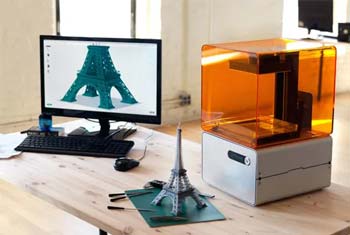
Printer Size
For most architects, this is the most important factor as the printer size and printing space determine how the dimensions of the models you print.
This means that architects who design larger buildings and statues need a bigger printer, such as the ANYCUBIC Chiron 3D Printer or the Dremel DigiLab 3D45 3D Printer.
On the other hand, those looking for a 3D printer that can produce more miniature models will prefer something like the FlashForge 3D Printer Creator Pro. These smaller printers also save space and are a good choice for amateurs and hobbyists.
Read More: How Long Does it Take to 3D Print a Small Object? We talk miniatures and printing times in this guide!
Printer Speed
This is another important aspect that differs from printer to printer. The general rule of thumb is that the printers that more detailed 3D models are slower, while faster printers produce less finetuned prints. If you want a 3D printer that works more quickly, QIDI TECH 3D Size X-Plus Printer is a better option.
On the other hand, the Ultimaker 3 Extended 3D Printer is slower but creates more detailed prints. If you want to strike the right balance between speed and detail, Dremel DigiLab 3D45 3D Printer is a suitable option.
Read More: Does 3D Printing Use a Lot of Electricity? We discuss the average energy consumption of 3D printing and how to reduce your usage!
Connectivity
Different 3D printers utilize different methods of connectivity. Older models used USBs and Ethernet cables, but newer models use Wi-Fi connectivity. However, the Dremel DigiLab 3D45 3D Printer offers all 3 options for connectivity, which provides you with a backup plan in unforeseen circumstances.
Filament Material
It is generally recommended that you choose a printer that can use a variety of filament materials. This is because most older models can only produce prints using one or two materials, which limits the scope of the 3D printed models.
Instead, architects would do best with printers like Monoprice Maker Ultimate 3D Printer, FlashForge 3D Printer Creator Pro, and QIDI TECH 3D Size X-Plus Printer as they can utilize different filament materials in the 3D models.
Read More: What Can Dissolve PLA? Dissolving PLA has never been easier!
Software Compatibility
Some 3D printers can print files produced on any CAD software while others need you to use their software or convert your designs to a certain format. As a result, you should make sure your printer is compatible with the software you have, or get a model that is compatible with most software like the Ultimaker 3 Extended 3D Printer.
Read More: How Does 3D Resin Printer Work? Discover how resin printers work, their pros and cons, and if they’re worth the buy in this guide!
Top 3 Lists Of 3D Printing Software For Architects
Fusion 360
This 3D printing software combines design, engineering, PCB design, and manufacturing into one platform. As a result, it delivers high-quality models, including generative designs, advanced simulation, and provides the finest print quality for architects everywhere.
Tinkercad
For architects new to 3D printing, simple printing software is easier to handle. Tinkercad is a straightforward software that doesn’t need an expert to navigate through and is perfectly suited to making prototypes and allowing rough sketches to come to life.
Ultimaker Cura
Ultimaker Cura gets your model ready for 3D printing. It uses an industry-standard software integration, allowing you to streamline your workflow for the most efficiency.
Check out our post on SQ4D 3D Printing, a business that prints 3D HOUSES!
3D Printing Architectural Models Costing Idea
Students, interns, and new architects often worry about the costs associated with 3D printed models. Aside from factoring in the cost of your 3D printer, the cost of the models will depend on the filament material used to print the model.
For instance, materials like PLA and ABS filaments are more common and affordable. On the other hand, if your model requires more exotic materials like magnetic, metal, and conductive filaments, the price will rise significantly.
The cost also depends on the size of your model. Larger models that need different materials will be much more expensive than smaller and simpler models made from PLA or PC.
With all that in mind, depending on the size and material used, a 3D architectural model can range from $1000 to over ten thousand dollars. A medium-sized 3D model with a build volume of 7.8×7.8×10 inches will cost anywhere from 1,000 to $2,500. And this cost can increase exponentially when using pricier filaments.
Read More: 3D Printer Setup Guide. Setup is easier than you think! We cover 3D printer setup in this quick guide for beginners.
Frequently Asked Questions
1. Which Kind Of 3D Printer Is Most Commonly Used By Architects?
Architects most often use FDM and SLA (stereolithography) 3D printers for prototyping and creating realistic and life-like models. These printers are most commonly sold to consumers, including professionals like architects, interior designers, and engineers.
2. Why Do Architects Use 3D Printers?
3D printers save time as architects no longer have to create models by hand. Moreover, 3D printers allow architects to use a variety of materials and make the models look more realistic and detailed.
3. Which Is The Strongest Filament Material For 3D Printing?
ABS and TPU are the strongest filament materials that you can use when printing 3D printers. These materials are strong, yet lightweight and flexible.
Read More: What is TPU Filament Good For? We cover everything you need to know about TPU filament in this guide!
4. Which 3D Printers Print Faster; FDM, Or SLA?
FDM is faster when it comes to printing when compared to SLA because FDM can print with much thicker layers and rarer infill, which decreases print times. However, DLP and LCD printers can produce models faster than FDM ones.
Read More: How Long Does 3D Printing Take? This guide for beginners is a great place to start to learn what to expect from 3D printing!
Final Word
At the end of the day, a lot of research and thinking is needed when choosing the best 3D printers for architects. Because there are so many different kinds of printers out there, the features of each are meant to respond to different consumer needs.
Just make sure you know what you want from your 3D printer, check out the buying guide and mentioned above, and choose the one that matches your requirements. It really is that simple!
We hope our extensive article on architect’s 3d modeling printer could help you to pick the best one. If you want to more about many other printers that will be used for different purposes, we’ve done on our website.





